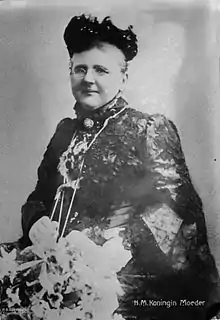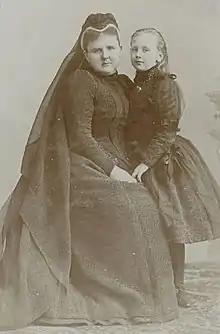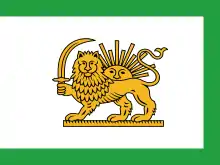Emma of Waldeck and Pyrmont
Emma of Waldeck and Pyrmont (Adelheid Emma Wilhelmina Theresia; 2 August 1858 – 20 March 1934) was Queen of the Netherlands and Grand Duchess of Luxembourg as the wife of King-Grand Duke William III. An immensely popular member of the Dutch Royal Family, Queen Emma served as regent for her daughter, Queen Wilhelmina, during the latter's minority from 1890 until 1898. She was a maternal third cousin of Queen Mary, consort of British king George V.
| Emma of Waldeck and Pyrmont | |||||
|---|---|---|---|---|---|
 Emma as queen mother in 1900 | |||||
| Queen consort of the Netherlands Grand Duchess consort of Luxembourg | |||||
| Tenure | 7 January 1879 – 23 November 1890 | ||||
| Born | 2 August 1858 Arolsen Castle, Arolsen, Waldeck and Pyrmont, German Confederation | ||||
| Died | 20 March 1934 (aged 75) Lange Voorhout Palace, The Hague, Netherlands | ||||
| Burial | Nieuwe Kerk, Delft, Netherlands | ||||
| Spouse | |||||
| Issue | Wilhelmina of the Netherlands | ||||
| |||||
| House | Waldeck and Pyrmont | ||||
| Father | George Victor, Prince of Waldeck and Pyrmont | ||||
| Mother | Princess Helena of Nassau | ||||
Early life
Emma was born a princess of Waldeck and Pyrmont on 2 August 1858 in Arolsen Castle in Arolsen, the capital of the small German principality of Waldeck and Pyrmont. She was the fourth daughter of Georg Viktor, Prince of Waldeck and Pyrmont, and Princess Helena of Nassau-Weilburg. Her brother, Friedrich, was the last reigning prince of Waldeck and Pyrmont. Her sister, Helena, was the wife of Prince Leopold, Duke of Albany, a son of Queen Victoria.
Her maternal grandfather was William, Duke of Nassau, a grandson of Princess Carolina of Orange-Nassau, through which she inherited a place in the line of succession to the Dutch Crown until 1887.
Emma had a religious education from a very liberal minded pastor. With her English governess, Emma studied crafts, drawing, and French literature. Her upbringing has been described as fairly informal, though with a focus on a sense of duty.[1] She was given an interest for social work early on due to the charity work she became involved in already as young, and an interest for medical work due to the illness of her eldest sister, who suffered from tuberculosis.[1] Emma was described as tactful, sensible and engaging.[1]
Queen

Princess Emma married the elderly King William III in Arolsen on 7 January 1879, two years after the death of his first wife, Sophie of Württemberg.[2][3]
The marriage was suggested during William's visit to Pyrmont in 1878. It was an arranged dynastic marriage and Emma agreed because of the sense of religious duty she had been raised to, in order to benefit the dynastic marriage policy of her parents.[1] During the engagement, she was given lessons in the Dutch language and politics.[1]
The king had three sons from his first marriage, William, Maurice, and Alexander, all of whom died without any legitimate offspring.[2] With William, Emma had her only child, the future Queen Wilhelmina, on 31 August 1880. When her last surviving stepson Alexander, Prince of Orange died in 1884, her daughter became heir to the throne. This changed Emma's own position, since it was likely that her daughter would succeed her spouse as a minor, in which case Emma herself would be regent during her minority.
During these years, the king retired from public life due to his health condition, and Emma was given the task to act as his nurse.[1]
Regency
Three days before William died on 23 November 1890, Emma became regent for her incapacitated husband. She continued her regency into the reign of his successor, their underage daughter, Wilhelmina, until Wilhelmina's eighteenth birthday on 31 August 1898. The Grand Duchy of Luxembourg, the crown of which according to the House-Treaty should not be inherited by a woman, passed to Adolf, Duke of Nassau, who happened to be Queen Emma's maternal uncle.
Emma was the first woman to rule The Netherlands since Princess Carolina of Orange-Nassau a century before, and the first woman to rule the Kingdom of the Netherlands. She took her position of regent seriously. Her task was not simple, since William had antagonized many politicians with his autocratic ways. She managed to establish better relations between the royal house and the political world fairly quickly with good advisors, particularly Jhr J. Röell and Jhr GCJ van Reenen.[1] She met personally with every government minister at least once every two weeks to keep herself informed of all political issues, and strictly adhered to the rules of the constitutional monarchy. She used the trust she gained by respecting the constitutional forms by using her influence within political issues she did care about, which resulted in compromises in which she often managed to get her will.[1] One statesman commented that Emma was efficient because she combined a strong will with soft forms, something they had not been used to.[1]
As regent Emma presided over three cabinets. In 1891, Emma refused to appoint the suggested minister Johannes Tak van Poortvliet, with whom she had a tense relationship, in favor of G. van Tienhoven.[1] In 1894 she was convinced by Tak van Poortvliet to dissolve Parliament.[1] When a new cabinet was to be sworn in, she refused until she had read and approved of their political program.[1] In 1897, she demanded that both the Liberal parties was to be included in the new cabinet and the Aceh war was to continue, before she agreed to have the new government sworn in.[1] She wrote and held her speeches in Dutch, and engaged herself in the Dutch Colonial Empire, attending the military parades and celebrations associated with Imperial achievements.[1]
In addition to her administrative duties, Emma paid great attention to the education of her daughter. When Wilhelmina reached the age of 16, Emma considered her childhood over and Wilhelmina spent the next two years being prepared for her job as a reigning queen. During her government, she took Wilhelmina on tours through the provinces to visit local charities, hospitals, churches and factories and acquaint Wilhelmina with her future duties.
Queen mother
On August 31st 1898 her daughter queen Wilhelmina reached legal majority (inauguration on September 6th) and queen Emma thereby retired from regency. In her farewell speech as regent, she expressed her wish that The Netherlands should continue to be great in the way small nations could show greatness.[1]
Emma continued to live with her daughter until Wilhelmina's marriage to Henry of Mecklenburg in 1901, after which she moved to her own residence Lange Voorhout in The Hague. When her granddaughter Juliana was born in 1909, it was declared that in case Juliana succeeded to the throne as a minor, her grandmother Emma should be regent rather than her father.[1]
As queen mother Emma continued to attend to public royal representational duties, supporting her daughter and son-in-law, and was a well known figure in her black widow lace. She was called "queen of charity" and especially engaged in improvement of the conditions for those suffering from tuberculosis. She retired from public life when her granddaughter Juliana was declared adult and started to participate in public duties in 1927.[1]
The queen mother died in The Hague on 20 March 1934, of complications from bronchitis at the age of 75, and was buried in Delft.
Honours and arms

- Grand Cross of the Netherlands Lion
- Grand Cross of the Order of Orange-Nassau
- Grand Cross of the Order of the House of Orange
- Cross of Merit of the Red Cross
- Foreign orders and decorations[5]

.svg.png.webp) Austro-Hungarian Imperial and Royal Family: Grand Cross of the Order of Elizabeth
Austro-Hungarian Imperial and Royal Family: Grand Cross of the Order of Elizabeth.svg.png.webp) Belgium: Grand Cordon of the Order of Leopold (civil), August 1898[6]
Belgium: Grand Cordon of the Order of Leopold (civil), August 1898[6].svg.png.webp) France: Grand Cross of the Legion of Honour, December 1896[7]
France: Grand Cross of the Legion of Honour, December 1896[7].svg.png.webp) German Imperial and Royal Family: Dame of the Order of Louise, 1st Division, 30 May 1892[8]
German Imperial and Royal Family: Dame of the Order of Louise, 1st Division, 30 May 1892[8]
.svg.png.webp) Empire of Japan: Grand Cordon of the Precious Crown, 18 June 1898[9]
Empire of Japan: Grand Cordon of the Precious Crown, 18 June 1898[9] Persian Imperial Family: Order of the Sun, 1st Class
Persian Imperial Family: Order of the Sun, 1st Class.svg.png.webp) Portuguese Royal Family: Dame of the Order of Queen Saint Isabel
Portuguese Royal Family: Dame of the Order of Queen Saint Isabel Russian Imperial Family: Grand Cross of St. Catherine
Russian Imperial Family: Grand Cross of St. Catherine.svg.png.webp) Spain: 812th Dame of the Order of Queen Maria Luisa, 29 March 1880[10]
Spain: 812th Dame of the Order of Queen Maria Luisa, 29 March 1880[10].svg.png.webp) Siam: Dame of the Order of the Royal House of Chakri, 7 September 1897[11]
Siam: Dame of the Order of the Royal House of Chakri, 7 September 1897[11].svg.png.webp) Turkish Imperial Family: Grand Cordon of the Order of Charity
Turkish Imperial Family: Grand Cordon of the Order of Charity
Ancestry
| Ancestors of Emma of Waldeck and Pyrmont |
|---|
References
- Redactie, Emma Wilhelmine Therese van Waldeck-Pyrmont, in: Digitaal Vrouwenlexicon van Nederland. URL: http://resources.huygens.knaw.nl/vrouwenlexicon/lemmata/data/Emma [24/03/2014]
- George Edmundson, History of Holland (2013), p. 421
- David Williamson, Debrett's Kings and Queens of Europe (1988), p. 101
- (Parlement.nl)
- Staatsalmanak voor het Koninkrijk der Nederlanden, 1921, "Koninkrijk Huis der Nederlanden" p. 2
- "Liste des Membres de l'Ordre de Léopold", Almanach Royale Belgique (in French), Bruxelles, 1899, p. 74 – via hathitrust.org
- M. & B. Wattel (2009). Les Grand'Croix de la Légion d'honneur de 1805 à nos jours. Titulaires français et étrangers. Paris: Archives & Culture. pp. 500, 597. ISBN 978-2-35077-135-9.
- "Luisen-orden", Königlich Preussische Ordensliste (supp.) (in German), vol. 1, Berlin, 1886, p. 116 – via hathitrust.org
- 刑部芳則 (2017). 明治時代の勲章外交儀礼 (PDF) (in Japanese). 明治聖徳記念学会紀要. p. 157.
- "Real orden de Damas Nobles de la Reina Maria Luisa". Guía Oficial de España (in Spanish). 1898. p. 178. Retrieved 21 March 2019.
- Royal Thai Government Gazette (7 May 1899). "พระราชทานเครื่องราชอิสริยาภรณ์ที่ประเทศยุโรป (ต่อแผ่นที่ ๕ หน้า ๖๔)" (PDF) (in Thai). Retrieved 8 May 2019.
{{cite journal}}: Cite journal requires|journal=(help)
External links
| Wikimedia Commons has media related to Emma of Waldeck and Pyrmont. |
- (in Dutch) Koningin Emma (1858–1934) at the Dutch Royal House website
- Newspaper clippings about Emma of Waldeck and Pyrmont in the 20th Century Press Archives of the ZBW